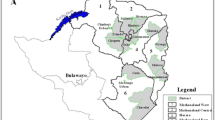Abstract
Strawberry lethal yellows (SLY) disease in Australia is associated with the phytoplasmas Candidatus Phytoplasma australiense and tomato big bud, and a rickettsia-like-organism (RLO). Ca. P. australiense is also associated with strawberry green petal (SGP) disease. This study investigated the strength of the association of the different agents with SLY disease. We also documented the location of SLY or SGP plants, and measured whether they were RLO or phytoplasma positive. Symptomatic strawberry plants collected from south-east Queensland (Australia) between January 2000 and October 2002 were screened by PCR for both phytoplasmas and the RLO. Two previously unreported disease symptoms termed severe fruit distortion (SFD) and strawberry leaves from fruit (SLF) were observed during this study but there was no clear association between these symptoms and phytoplasmas or the RLO. Only two SGP diseased plants were observed and collected, compared with 363 plants with SLY disease symptoms. Of the 363 SLY samples, 117 tested positive for the RLO, 67 tested positive for Ca. P. australiense AGY strain and 11 plants tested positive for Ca. P. australiense PYL variant strain. On runner production farms at Stanthorpe, Queensland the RLO was detected in SLY diseased plants more frequently than for the phytoplasmas. On fruit production farms on the Sunshine Coast, Queensland, Ca. P. australiense was detected in SLY disease plants more frequently than the RLO.
Similar content being viewed by others
References
Alma A, Davis RE, Vibio M, Danielli A, Bosco D, Arzone A, Bertaccini A (1996) Mixed infection of grapevines in northern Italy by phytoplasmas including 16S rRNA RFLP subgroup 16SrI-B strains previously unreported in this host. Plant Disease80, 418–421.
Altschul SF, Madden TL, Schaffer AA, Zhang J, Zhang Z, Miller W, Lipman DJ (1997) Gapped BLAST and PSI-BLAST: a new generation of protein database search programs. Nucleic Acids Research25, 3389–3402. doi: 10.1093/nar/25.17.3389
Andersen MT, Beever RE, Gilman AC, Liefting LW, Balmori E, Beck DL, Sutherland PW, Bryan GT, Gardner RC, Forster RLS (1998a) Detection of Phormium yellow leaf phytoplasma in New Zealand flax (Phormium tenax) using nested PCRs. Plant Pathology47, 188–196. doi: 10.1046/j. 1365-3059.1998. 00209.x
Andersen MT, Longmore J, Liefting LW, Wood GA, Sutherland PW, Beck DL, Forster RLS (1998b) Phormium yellow leaf phytoplasma is associated with strawberry lethal yellows disease in New Zealand. Plant Disease82, 606–609.
Broadley RH, Waite GK, Gage J, Greber RS (1988) ‘Strawberry pests.’ (Department of Primary Industries, Queensland Government: Brisbane)
Constable FE, Gibb KS, Symons RH (2003) Seasonal distribution of phytoplasmas in Australian grapevines. Plant Pathology52, 267–276. doi: 10.1046/j.l365-3059.2003.00849.x
Davis MJ, Ying Z, Brunner BR, Pantoja A, Ferwerda FH (1998) Rickettsial relative associated with papaya bunchy top disease. Current Microbiology36, 80–84. doi: 10.1007/ S002849900283
Deng S, Hiruki C (1991) Amplification of 16S rRNA genes from culturable and non-culturable Mollicutes. Journal of Microbiological Methods14, 53–61. doi: 10.1016/0167-7012(91) 90007-D
Doyle JJ, Doyle JL (1990) Isolation of plant DNA from fresh tissue. Focus (San Francisco, Calif.)12, 13–15.
Franova J, Karesova R, Varatil M, Simkova M, Valova P, Nebesarova J (2000) A carrot proliferation disease associated with rickettsia-like organisms in the Czech Republic. Journal of Phytopathology149, 53–55. doi: 10.1046/j. 1439-0434.2000.00465.X
Gibb KS, Constable F, Moran J, Padovan AC (1999) Phytoplasmas in Australian grapevines — detection, differentiation and associated diseases. Vitis38, 107–114.
Greber RS (1987) Strawberry Rickettsia yellows and mycoplasma yellows. In ‘Virus diseases of small fruit.’ (United States Department of Agriculture)
Greber RS, Gowanlock DH (1979) Rickettsia-like and Mycoplasma-like organisms associated with two yellow-type diseases of strawberries in Queensland. Australian Journal of Agricultural Research30, 1101–1109. doi: 10.1071/AR9791101
Lee I-M, Bertaccini A, Vibio M, Gundersen DE (1995) Detection of multiple phytoplasmas in perennial fruit trees with decline symptoms in Italy. Phytopathology85, 728–735.
Lee I-M, Davis RE, Gundersen-Rindal DE (2000) Phytoplasmas: Phytopathogenic mollicutes. Annual Review of Microbiology54, 221–255. doi: 10.1146/annurev.micro.54.1.221
Lee I-M, Gundersen-Rindal DE, Bertaccini A (1998) Phytoplasma: ecology and genomic diversity. Phytopathology88, 1359–1366.
Lee I-M, Martini M, Bottner KD, Dane RA, Black MC, Troxclair N (2003) Ecological implications from a molecular analysis of phytoplasmas involved in an aster yellows epidemic in various crops in Texas. Phytopathology93, 1368–1377.
Liefting LW, Padovan AC, Gibb KS, Beever RE, Andersen MT, Newcomb RD, Beck DL, Forster RLS (1998) ‘Candidatus Phytoplasma australiense’ is the phytoplasma associated with Australian grapevine yellows, papaya dieback and Phormium yellow leaf diseases. European Journal of Plant Pathology104, 619–623. doi: 10.1023/A:1008693904427
Lorenz K-H, Schneider B, Ahrens U, Seemuller E (1995) Detection of the apple proliferation and pear decline phytoplasmas by PCR amplification of ribosomal and nonribosomal DNA. Phytopathology85, 771–776.
Padovan AC, Gibb KS, Bertaccini A, Magarey PA, Sears BB (1995) Molecular detection of the Australian grapevine yellows phytoplasma and comparison with grapevine yellows phytoplasma from Italy. Australian Journal of Grape and Wine Research1, 25–31.
Padovan AC, Gibb KS, Persley D (2000) Association of ‘Candidatus Phytoplasma australiense’ with green petal and lethal yellows disease in strawberry. Plant Pathology49, 362–369. doi: 10.1046/j. 1365-3059.2000.00461.x
Schneider B, Gibb KS (1997) Detection of phytoplasma in declining pears in southern Australia. Plant Disease81, 254–258.
Schneider B, Gibb KS, Padovan AC (1997) Sequence and RFLP analysis of the elongation factor Tu gene used in differentiation and classification of phytoplasmas. Microbiology143, 3381–3389.
Schneider B, Seemuller E, Smart CD, Kirkpatrick BC (1995) Phylogenetic classification of plant pathogenic mycoplasma-like organisms or phytoplasmas. Molecular and Diagnostic Procedures in Mycoplasmology1, 369–380
Author information
Authors and Affiliations
Corresponding author
Rights and permissions
About this article
Cite this article
Streten, C., Waited, G.K., Herrington, M.E. et al. Rickettsia-like-organisms and phytoplasmas associated with diseases in Australian strawberries. Australasian Plant Pathology 34, 157–164 (2005). https://doi.org/10.1071/AP05007
Received:
Accepted:
Published:
Issue Date:
DOI: https://doi.org/10.1071/AP05007




